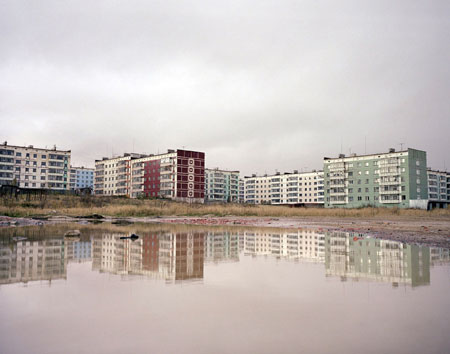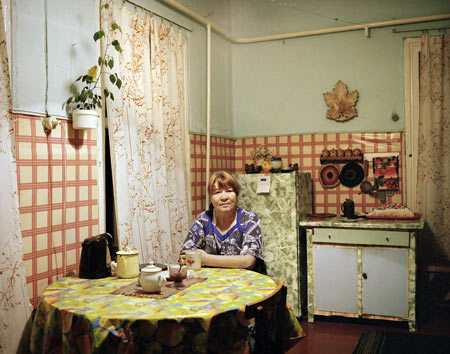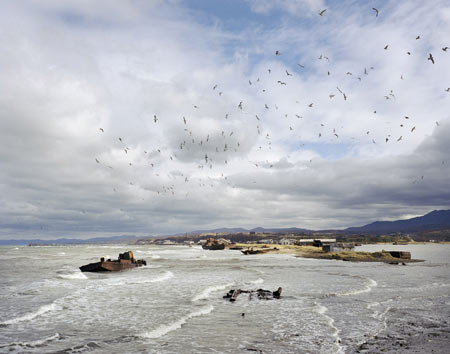A conversation with Simon Roberts

When Simon Roberts sent me a copy of his new book Motherland, I thought that instead of writing a review I could talk to him about the book. I am glad he agreed to participate.
Jörg Colberg: You set out to travel across Russia for quite an extended period of time. Did you have an idea about the photo project in your mind when you started the trip?
Simon Roberts: There were two reasons for choosing Russia. Firstly it was somewhere that had always fascinated me. I studied Human Geography at the University of Sheffield and a number of the courses I took looked at social, cultural and economic issues surrounding Russia and the former Soviet Union. Secondly, while there had been a number of important photo documentaries on Russia in the last decade, many were produced around the time of the fall of Communism, and tended to concentrate on themes surrounding disintegration and decay. I felt that the dialogue was very one sided and that the debate had moved on in recent years but photographic representations hadn’t. I was interested in exploring a different side to Russia and regions that had often been overlooked.
I’d only been to Russia once before, passing through in 1994 to visit my wife, Sarah, who was studying there. We decided that now would be a fascinating time to return, fifteen years after the fall of Communism. After researching the project for 18 months, we left London in July 2004 and spent the next 12 months travelling over 75,000km from the federation’s Far East, through Siberia to the Northern Caucasus, the Altai Mountains and along the Volga River. We finished in Moscow in July 2005.
The idea of using the concept of Rodina (Russian for motherland) for the framework of the book came about as I was traveling. The national pride among the Russians I met was much more powerful than I’d ever experienced before, especially when compared to Rule Britannia or patriotism in America. It was somehow less arrogant, slightly sorrowful and much more spiritual, almost a painful yearning of the heart. The majority of Russians we met were intensely proud of their homeland’s beauty and its achievements and I wanted the tone of the work to explore these themes.

JC: Did your formal training in Human Geography inform the work at all?
SR: Yes. My major thesis at university was undertaken while traveling on an overland truck from Kenya to Zimbabwe with a group of Western tourists. Using Edward Said’s concepts of ‘othering’ and ‘imagined landscapes’ my paper looked at Western representations of Africa, in particular those associated with the tourist literature advertising overland expeditions. The premise was that as Western tourists our imagery of Africa is one grounded in a colonial history; the 19th century European tradition of the expedition with adventurers such as Livingstone, Park and Thompson going out to explore and encounter distant and exotic lands. These images have been nurtured and re-enforced by the media and tap into a reservoir of ideas we have regarding colonialism, imperialism and representations of far away, exotic places and peoples. These ideas have also been appropriated by modern tourist companies in advertising ‘real’ African experiences; we, the tourist, are branded as adventurous travellers going out to experience the dark heart of Africa. My research concluded that even once East Africa had been encountered, it was very difficult to overcome the representations of place, engrained stereotypes if you like, that the individuals had brought with them.
In terms of Russia, there had been several important photo documentaries produced in previous years, however, while all conveyed their own truths about Russia I felt that many insisted on collapse and deterioration and on the consequences of the past, as opposed to the possibilities of the future. I wanted to move on from conventional interpretations and produce a more contemporary vision of modern Russia.
In representing Russia, I made every effort possible to move beyond my own preconceptions. For instance, spending a year there allowed for a greater depth of engagement with the landscapes and people that I came across. It also enabled a spontaneity - I could respond to diverse events and situations, and was neither constrained nor driven by the specific news agenda, time frame or editing process of a photojournalism assignment or commission. The sheer magnitude of the country and the unusually large distances covered, in turn allowed for a greater sense of conceptual and aesthetic comparison. I was constantly conscious about shedding my preconceptions and instead to be led by what I saw and experienced. If I had gone to Russia with the intention of documenting poverty, I would have looked for it - and found it. Instead I wanted to be as open as possible to new ideas and be surprised by what I found.

JC: How did your idea change as time went by and as you went to experience more and more of that huge country?
SR: It goes without saying that my own preconceptions were continually challenged. For instance, I was surprised by how well things were developing outside of the major conurbations, in small towns in Siberia and Far East Russia. In these places there was access to many international brands, sushi restaurants, the internet, and so on. The internet is really driving a lot of these small places, especially for young people. The youth are now getting access to everything that youth in the UK, America or Japan have access to. I suppose I knew I would find that, but I didn’t expect it to be so widespread.
Similarly, I was challenged by what constituted beauty. Russians, in the past at least, have been prepared to admit that their landscapes have lacked the picturesque detail of European vistas. This could equally be applied to rural or city space. Yet they see in these things the tokens of an extraordinary spiritual wealth and are the well-spring of the resilience, energy and spirituality of the Russian people. Where I might look upon an old Soviet apartment block in Okha (see picture of apartment reflected in water) as something drab, the residences may see it as their birthplace or a place where they belong. In this landscape, they see beauty. My challenge was to convey this message.
My overwhelming feeling in the end is one of cautious optimism about where Russia is heading. That’s not to say that there aren’t significant areas for concern, none the least, politically. However, this project was never intended to make a political statement.

JC: How did you decide what to take photos of? How does one go about trying to create a portrait of a country?
SR: My choice of subject was determined by several factors, one of which was the desire to illuminate the unknown parts of Russia, for example, the remote northerly province of Chukotka, or the indigenous people of the east. Also, situations and places that presented themselves in a surreal or surprising manner: a huge deflated crocodile ignored by a crowd of people in Yekaterinburg, or the peculiar beauty of three taxis trying to cross the Lena River in winter.
It was also very important that some of the trip was unplanned. While I had a framework for the journey, I deliberately left at least half of the itinerary to spontaneity, thereby increasing the chance for my own stereotypes to be challenged and opening up new avenues of exploration that I could otherwise have overlooked. By staying in peoples’ houses, rather than just hotels, I was able to find people and places that I would never have otherwise come across. In some ways enabling me to become an insider rather than just a tourist.
One of the greatest challenges was being able to submerge yourself in some of the larger cities, notably in Siberia, when you often only had a few days. How do you really get a sense of a particular place in a short period of time? You turn up, you book into a hotel, and then how do you integrate yourself into the local society? It’s very difficult. One way I overcame this was by using homestays (via hospitalityclub.org) where I sourced local families to stay with. Instead of just being overwhelmed by a place on arrival, I was immediately experiencing it from a local viewpoint. People introduced me to their friends and took me to places that I would never have found from a guidebook, or from our own research. In Omsk we stayed with a University professor who gave me a tour of his University and took me to the All Russia Ballroom Dance Contest, which his daughter was competing in (which led to the portrait of Nikita and Rufina); in Rostov-on-Don I stayed with a local journalist who gave me a tour of the Cossack military base (which led to the portrait of a Cossack soldier on the horse); in Yekaterinburg I stayed with Sergei who took me for a banya with his son Kostya (which led to the image of them in the lake); while in Kamchatka I spent five days trekking through the wilderness on horseback with Paval and Sasha (see the portrait of them by the campfire). Finally, in the small town of Port Baikal on the shores of Lake Baikal I was entertained by Luba (seen in her kitchen).
JC: Portraiture is part of your book, and I’d be curious about how you went about picking subjects. How did you decide about whose portrait to take?
SR: It was always my intention to combine both landscapes and portraits in the book. I used landscape photographs to provide panoramic overviews of the country, images that help to provide a sense of context, evoking peoples in their diverse habitats and surroundings. I was interested in making detailed pictures that the viewer could read, like a map, and find different cultural and social references in. Where possible, I tried not to crop out any significant details from the landscape I photographed.
These landscapes I countered with portraits that are fixed in a narrow moment of time and space and which take you in to the landscapes and provide a much more intimate experience. Most of my subjects were stopped and photographed in the environments where I came across them. I attempted to select as large a cross-section of people as possible, from all walks of life. The portraits were taken before engaging in conversation with the individual so I could remain as detached as possible and their expression appear deadpan. What becomes of greater importance are the details in the image; the clothes they are wearing and the landscapes they inhabit. The portraits are almost an anthropological study. As formal and static in nature as they are - I still think there is often an intimate connection between myself and the subject.

JC: Did you decide about including places like Grozny or locations of nuclear disasters beforehand? And were you worried about giving these places too much or too little emphasis? How did you go about what balance to find?
SR: In producing a balanced portrayal it was important not to gloss over the cracks of modern day Russia. Chechnya is still a profoundly emotive issue in Russian society and it would have been wrong to ignore or ‘sensor’ pictures from this region. The same was true of the portrait of the women from Karabalka where a nuclear disaster had happened a few decades earlier or the picture from the school in Beslan where over 300 people, mostly children, were killed. At the same time, you will notice that there are two very differing images in the book from Chechnya. While one shows the main outdoor market in Grozny in front of heavily shelled apartment blocks (in some ways a very typical image we’re used to seeing), the second shows a group of well-dressed Chechen women and their children in a part of Grozny that has been reconstructed. The latter is a surprising image in terms of our visual references, which have been dominated by the negative portrayal of Grozny. It was important that I showed both sides of the story.
Essentially the balance came in the editing process. I took about 5000 photographs, which have been edited down to 150 for the book. To help my documentation of Russia, most of the photographs are accompanied with measured and informative captions that deepen our understanding and help to contextualise the photographs. I also wanted to have the text on the same page as the photographs and the physical size of the book to be quite small, thereby enabling the viewer to ‘read’ the book rather than just look.
JC: The cracks of modern-day Russia appear to get more pronounced, though. For example, despite the reconstruction in Chechnya, the conflict there is essentially unsolved. Under President Putin, the country has been moving into a direction that cannot be accurately described as a democracy. Many of the Russian journalists or emigrants who covered this development are now dead, most of them murdered in a style reminiscent of the Stalinist past. Journalist Anna Politkovskaya was killed, execution-style in front of her apartment building. And famously, former spy Alexander Litvinenko was poisoned with a radioactive substance in London. Of course, it is hard to portray such a development, but since you are talking about Russia’s future, I’m sure you must have thought about these events. Were you concerned about them?
SR: As I mentioned earlier, there are many challenges to Russia’s future development, none more so than politically. The recent death of Politkovskaya and then Litvinenko were appalling. Sadly, there will probably be more such targeted assassinations in the future. The lack of independent media, in particular television, and the open bullying of opposition politicians as Russia approaches new Presidential elections in 2008, are also extremely worrying. However, most people are very aware of the political climate in Russia (it certainly always makes news headlines in the UK) and this is not something I felt I needed to talk about extensively in my own work. I was much more interested in looking at the idea of identity. Saying that, I have made subtle references to the current political scene, for instance with the inclusion of the Beslan massacre, Chechen IDPs in Ingushetia and the jailed oligarch, Mikhail Khordokosvy. As regards Chechnya, the conflict is a very different beast to what it once was. There is no longer open warfare on the streets of Grozny, and many Chechens are living much more ‘normal’ lives than they were ten years ago. I simply wanted to show that there was another side to the city, one which rarely gets mentioned. That’s not to say that I’m in any way diminishing the problems that still exist, of which I accept there are many.

JC: When you show(ed) your photos/your book to people living in or from Russia what reactions did you encounter?
SR: I’ve showed the work to a number of Russian friends and also at various presentations to audiences around the UK and in Moscow. In most cases the reaction has been very positive, especially among the younger generation. Interestingly, however, when I showed the work to a gallery owner in Moscow she didn’t think a Russian audience would be ready to see the work yet, rather it would take at least another five years before Russians would be ready to “look inwards”. I’m not so sure. Having created a website for the book where people can post their comments (www.motherlandbook.com), I’ve been pleasantly surprised by the reactions - “I’m happy that one can show the beautiful land that Russia is and tell about it with such great love as you do” (Natalja), “Thank you, I have never seen my motherland from this side” (Roman) and finally from Ida “I almost cried….yes, that’s where I came from.”
 By
By